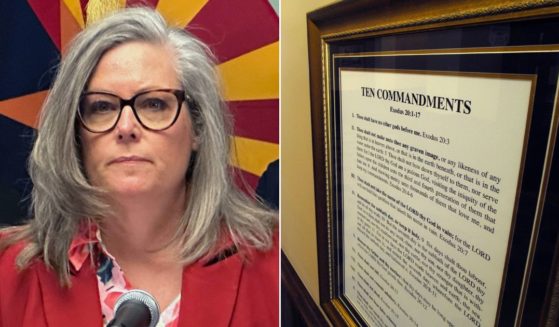By the Numbers: Here's How Members of Congress Did on Facebook in April
Engagement on Facebook pages associated with members of both major political parties has continued to fluctuate in the year following the social media giant’s major algorithm changes in 2018, according to a continued analysis by The Western Journal.
The year 2018 was full of challenges for the social media platform. Lawmakers and politicians have repeatedly questioned the credibility of Facebook’s claims of being an unbiased social media platform.
Facebook also experienced a series of data breaches that brought security and privacy to the forefront of concerns about social media.
In a November 2018 article for The Epoch Times, Robert Epstein outlined how Big Tech companies like Facebook can shift votes in elections.
“Facebook can affect election outcomes in at least five different ways: by biasing its trending box, biasing its center newsfeed, encouraging people to look for election-related material in its search bar, sending out targeted register-to-vote reminders, and sending out targeted go-out-and-vote reminders.”
Big Tech companies deny that their algorithms can be tweaked to meddle in elections, but the effects of the algorithm changes can be seen in the numbers.
According to ongoing analysis of more recent data, pages associated with members of both major political parties saw a significant decrease in interactions with readers following the change in January 2018.
Analysis of data from April shows that there still seems to be a disparity in interaction rate on Republican and Democratic congressional Facebook pages, but the interaction rate follows the same general trend throughout the month.
The Numbers
The Western Journal recently analyzed the interaction rates on congressional Facebook pages from April 2019.
Interaction rates are the average interactions (likes, shares or comments on a post) divided by the number of page followers for each page. Regardless of a change in the number of posts or followers, the interaction rate on a given Facebook page should remain similar from month to month, all else being equal.
For comparison, previous analysis had shown pages operated by congressional Democrats had an average interaction rate of 0.80 percent for the month of March, whereas pages owned by their Republican counterparts saw an average interaction rate of 0.55 percent.
Speaking generally, interaction rates for both Democrat and Republican congressional pages were fairly even for most of April but started to trend downward toward the end of the month.
In the first week of April (April 1 – April 6), Democratic pages had a 0.57 percent interaction rate, while Republican pages had a 0.55 percent interaction rate.
During the week of April 7 – April 13, there was a 0.62 percent interaction rate on Democratic pages and a 0.46 percent interaction rate on Republican pages.
From April 14 – April 20, Democratic pages has a 0.75 percent interaction rate compared to a 0.53 percent interaction rate on Republican pages.
In the last full week of April (April 21 – April 27), Democratic pages had a 0.51 percent interaction rate, while there was a 0.40 percent interaction rate on Republican pages.
There was a busy news cycle in the month of April.
During a town hall meeting in Muscatine, Iowa, on April 6, Democratic presidential candidate Sen. Bernie Sanders called for allowing criminals serving prison time for felonies to vote in elections.
Former Vice President Joe Biden officially launched his long-anticipated 2020 bid with a video announcement on April 25, quoting the Declaration of Independence and arguing President Donald Trump is actively undercutting its ideal of equality for all.
Tragedy struck on April 15 when the iconic Notre Dame Cathedral in Paris, France, caught fire.
On April 17, many Denver area schools were closed as law enforcement conducted a “massive manhunt” to locate a young Florida woman “infatuated” with the 1999 Columbine High School shooting, days before the 20th anniversary of the shooting.
The woman, 18-year-old Sol Pais of Florida, was tracked down to Echo Lake Lodge near the base of Mount Evans, a wilderness area about 60 miles west of Denver, where she was found dead.
On April 27, there was a shooting at a synagogue in Poway, California, just outside of San Diego.
A 19-year-old suspect opened fire in the synagogue, injuring three people and killing one woman, Lori Kaye. Kaye jumped in front of Rabbi Yisroel Goldstein in order to shield him from the incoming bullets.
Like March, the release of the Mueller report took up a large proportion of the news cycle and was widely discussed among politicians. The over 400-page redacted report was released on April 18.
In the House of Representatives, there was a 0.75 percent interaction rate on Democratic pages and a 0.93 percent interaction rate on Republican pages during the week of April 1 – April 6.
Interaction rates during the week of April 7 – April 13 were even with a 0.76 percent interaction rate on both Democratic and Republican pages.
There was a 1.00 percent interaction rate on Democratic pages and a 0.91 percent interaction rate on Republican pages from April 14 – April 20.
During the week of April 21 – April 27, Democratic pages had a 0.59 percent interaction rate compared to a 0.64 percent interaction rate on Republican pages.
In the Senate, there was a 0.39 percent interaction rate on Democratic pages and a 0.17 percent interaction rate on Republican pages during the week of April 1 – April 6.
Interaction rates during the week of April 7 – April 13 were at 0.48 percent for Democratic pages and 0.16 percent for Republican pages.
During the week of April 14 – April 20, there was a 0.50 percent interaction rate on Democratic pages and a 0.15 percent interaction rate on Republican pages.
In the last full week of April (April 21 – April 27), Democratic pages had a 0.42 percent interaction rate compared to a 0.16 percent interaction rate on Republican pages.
Democratic senators generally have a higher number of posts throughout the month than Republican senators. However, interaction rates should remain similar regardless of a change in the number of posts or followers.
Why This Matters
In January 2018, Facebook CEO Mark Zuckerberg announced that the social media platform would be rolling out a new algorithm. This algorithm would prioritize “friends, family and groups” in users’ News Feeds and show fewer public content, such as posts from “businesses, brands and media.” The decrease in interaction rates on these representatives’ pages indicates that some pages have indeed been unevenly impacted, intentionally or unintentionally, since this change was made.
This change continues to have serious implications for the future.
According to a July analysis by The Western Journal, Facebook pages associated with members of Congress from both major parties saw a significant decrease in interactions with readers in the months immediately following that algorithm change. However, the Facebook pages of Republican members of the House and Senate were affected more than those of their Democratic counterparts.
This means that Americans who stay informed about their elected representatives by following the Facebook pages of their state’s senators and representatives are less likely to see posts from these pages.
Additionally, if representatives are hindered in their ability to deliver their stance on issues to the people they represent, the public is less likely to know where they stand on the issues — leading to an uninformed public that could swing elections.
It could be argued that the closing of the gap in interaction rates between Republican and Democratic politicians follows a closing of the “enthusiasm gap” between Republican and Democratic voters.
Where the Data Comes From
To conduct this evaluation, The Western Journal extracted Facebook data from CrowdTangle for all current members of Congress with an official Facebook page, using CrowdTangle’s lists: U.S. House Democrats, U.S. Senate Democrats, U.S. House GOP and U.S. Senate GOP.
The Western Journal also used CrowdTangle’s calculation of each chamber of Congress’ weekly interaction rate. Those weekly interaction rates were then combined by taking the average of the two to find the interaction rate for Republican and Democratic congressional Facebook pages.
This data measures users’ interactions with the posts and not the reach of the post. Reach data is available only to individual publishers and is not made public by Facebook. However, the interactions are good general indicators of reach because when more users see a given post, interactions with that post should rise accordingly.
The fact that Facebook only reveals a limited amount of data regarding public pages — and essentially no data at all about the algorithm used to show posts on users’ News Feeds — in turn limits the ability of users, journalists and others to analyze cause and effect.
Facebook’s significant lack of data transparency makes it impossible for The Western Journal, government regulators or anyone else to defend Facebook’s internal processes as unbiased, make a credible accusation of intentional bias or make any sort of defensible statement in between.
Therefore, The Western Journal has analyzed the data available to us in this analysis as well as others.
Truth and Accuracy
We are committed to truth and accuracy in all of our journalism. Read our editorial standards.












